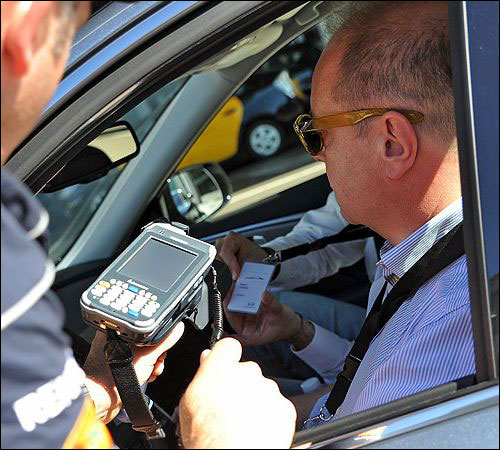Automotive companies show off their newest cars to journalists and others during their new product release events. They typically hire logistics agencies to manage all aspects of the presentation, including the movement of vehicles to the event site in transport (often enclosed) trucks, as well as before, during and after they are presented to, and driven by, journalists.
One such car logistics agency is Driving Events, based in Barcelona, Spain. Last year, Driving Events began using RFID technology to quickly identify the driver of each new car as it enters or exits a specific area, thereby reducing traffic delays and the fines associated with that traffic. The solution, including software on a hosted server to manage the collected tag-read data, is provided by Spanish RFID company Dipole RFID. Driving Events now intends to use the technology at most of the car presentations for its clients going forward.

From the time that the vehicles leave the factory until the end of the event, everything that happens is controlled by the management team at Driving Events, says Joan Montaner, Driving Events’ RFID manager. That includes getting cars to the site where reporters will pick them up, distributing keys to those journalists and providing drivers with an approved route to follow. That route, which Driving Events configures uniquely for each program to best showcase the characteristics of a particular new vehicle model, must first be approved by local authorities. Driving Events then collects the necessary permits for the event and the specific vehicles that will be traveling on that route. Journalist drivers are provided with a road book (a tablet running software from Driving Events that displays the route) indicating where to drive, which directs them to the appropriate secondary route if a diversion is required.
Putting journalists and others behind the wheel and allowing them to drive new vehicles around city streets, to hotels and other locations, is a complex endeavor. For instance, moving them onto and off of the facility’s property, while ensuring that the cars are being operated by authorized individuals and are returned when expected, can cause traffic backups. The delays around these processes often result in traffic tickets being issued to vehicles’ owners (the automotive companies) as cars queue up and slow traffic on the roads. In addition, some reporters operate the vehicles in unauthorized ways, such as speeding on rough roads or in parking areas. Local authorities send any tickets resulting from such activities directly to the car manufacturer. In fact, for the automotive companies, traffic fines have been just one more cost of doing business.
There are some ways in which Driving Events could reduce the amount of time that cars spend in queues waiting (there could be between 25 and 100 vehicles in use at any given time), such as providing ID cards that workers could check visually, or by means of a bar-code scanner. However, these solutions still took long enough that queues developed and traffic fines were issued.
“The problem was not only the time issue, but also having to carry lists done by hand,” Montaner says. The manual method invited the potential for errors, he explains. There was “the danger of losing the information,” as well as the need to manually key in data written on paper.
“We wanted to improve the method that was being used [to create] 100 percent reliability on the data,” Montaner states, “and not having to fear for the loss of it.”
The solution is an RFID system involving a Smartrac white PVC card made with an Impinj Monza 4D UHF RFID chip and incorporated into a badge worn by each authorized driver, as well as a Dipole windshield label with a Smartrac DogBone (Monza 4QT) inlay, attached to each vehicle. The unique ID number encoded to a vehicle’s windshield tag is stored with the ID encoded to the person’s badge tag, as well as information about that driver—such as the company that individual works for, as well as his or her name—in Dipole RFID’s software on a cloud-based server. An authorized Driving Events staff member can then log into the Driving Events Tracking Tags website, hosted by Dipole RFID, to view that data.
The hosted software provides all of the information regarding where a driver’s badge tag has been read, along with any instances of a driver not arriving at the correct location when expected. “You can add events and configure it, add all the guest, cars and routes,” to the system, explains Santiago Depares Aguilar, Dipole RFID’s sales manager. The software also provides analytics showing, via integration with Google Maps, where each vehicle and journalist reported, as well as when this occurred. After the event, Driving Events can then share that data with its customer—the auto manufacturer.
When a driver takes a car to a new location, such as to a hotel, or back to the automotive company’s facility, that individual is met by a Driving Events worker equipped with a Nordic ID handheld reader. The Driving Events employee can then quickly read the IDs encoded to the driver’s RFID badge and the vehicle’s windshield tag, and approve the arrival or departure of that driver without any prolonged stops. The collected data is stored on the handheld unit, or is sent directly to the server via a Wi-Fi or cellular connection.
Montaner believes that the RFID technology has shown its value. “We are improving event after event,” he says. “Basically, we have improved our timing. For us, the future of this technology is to use it in every single event we do.”
The first event, Nissan Live, was held last year in Slovakia’s capital city, Bratislava, which extended throughout the course of one month and hosted approximately 4,000 journalists. The next event in which Driving Events will use the solution will be the SEAT conference, to be held on June 21 in Barcelona.



